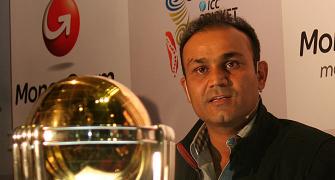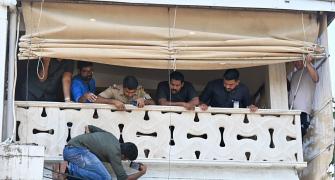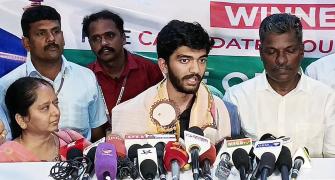
Sanjeeb Mukherjee, who was eight years old when the deadly gas leaked from Union Carbide's factory, gives his account of living in the city during that fateful period.
“Abba,” Pyare Mian told his bedridden father-in-law before locking the door of his house from outside, “We are running for our lives. Keep drinking water. If God wishes, we will meet again.” A noxious gas was spreading fast through the city’s air.
Nobody knew what to do. The primal instinct for survival, for running away, had taken over. Hafiz Khan, a relative, came to the house the next morning to inquire about the family. The old man was still alive -- he had been drinking water all night. Pyare Mian and his family who had tried to flee at night lay dead on the streets. They were the victims of the methyl isocyanate gas leak from the Union Carbide factory in Bhopal on the intervening night of December 2 and 3 in 1984.

Uncle Hafiz’s rendering of what he saw that day is clearly etched in my mind 30 years after the world’s worst industrial accident left thousands dead. He was my father’s colleague at the Bharat Heavy Electricals Ltd factory at Bhopal. Its township was truly a temple of modern India -- people from all over the country lived together as one. Caste and community divides didn’t exist: your neighbours were your support system. Uncle Hafiz would often pour his heart out to father.
I was 8 when the gas leak happened. My memories of those days are a mix of incidents narrated by people like uncle Hafiz and what I saw. The import of some of the incidents I saw became clear only later in life.
December 3 had begun like any other day. It was cold and the woollens were out. We were getting ready for school. My parents and neighbours were discussing some accident that had happened the night before, but it didn’t seem serious enough for them to stop us from going to school. The two words that still ring in my ears from those conversations are “gas” and “Carbide”.

The school bus came on time, picked us up and started its 10-km journey. The route was familiar: through neatly laid out government quarters and a small lake. It was away from the hustle-bustle of the old city, yet the silence on the streets that morning was eerie. There was not a soul in sight. There were at least 45 of us kids on the bus. Just as we reached the school gate, our teacher, Miss Aristotle, came running towards us and asked the driver to turn back. She was shouting at the top of her voice like a woman possessed. Her courage and sense of duty saved our lives.
Back home, father was frantically looking for some contact numbers of Union Carbide because two of our relatives worked there. He let out a sigh of relief when he was told that both of them had been on the day shift. That had saved them from the toxic gas. By noon, we had come to know about the nature of the accident and had some idea of the damage it had caused. There was no 24X7 news television at the time and the telecom network was pathetic. Information, and rumours, spread through word of mouth.
It was almost evening when the full extent of the tragedy became known to us. Some neighbours had visited the BHEL hospital to get first-hand information; others went along out of curiosity. They doubled back to narrate the horrific scenes they had seen: dead bodies were piled on the pathways and hundreds of men and women lay on the beds and in the corridors. Some just squatted in the open, their eyes popping out of their sockets. Quite a few rubbed their chest vigorously as they gasped for fresh air.

The limited staff in the hospital was not able to attend to the innumerable patients affected by the mysterious gas leak from a plant that represented the city’s attempt to put itself on the country’s industrial map. Doomsday was upon Bhopal, it seemed.
For some like D K Satpathy, then joint director of Medico Legal Institute in Bhopal’s Hamidia Hospital (also known as Gandhi Medical College), the day had started much earlier with a frantic phone call. “Death has occurred beyond imagination. Reach the mortuary as soon as possible,” Harish Chander, Satpathy’s senior, roused him.
“Some gas has leaked from the Union Carbide plant and patients are pouring in.”

Satpathy could sense despondency in his senior’s voice. Still wearing his night suit, the 35-year-old doctor rushed to the hospital from his government-provided accommodation in Idgah Hill, an upmarket locality. Nothing had prepared him for what he saw. The entire campus was teeming with people wailing, screaming and searching for loved ones among the patients. Thousands more poured in within hours.
Seated in a cot in the drawing room of his colonial-style bungalow in Bhopal, opposite the Governor’s house, Satpathy recounts that nobody knew what had struck the city as there was no medical history -- neither of these symptoms nor of the antidotes for them.
In order to understand the symptoms, Satpathy rushed to the casualty ward. His colleague, Deepak Gandhe, who was manning the ward, recounted that around midnight, 7 or 8 people had come to the hospital from colonies close to the Union Carbide factory, all gasping for breath, their eyes swollen. He had called the Union Carbide medical officer, who had glossed over any concern, saying that methyl isocyanate was nothing but teargas in a different form and could be controlled by simply washing the face with running water.

Even as the medical officer was reassuring him that the gas was harmless, Gandhe saw people who had just come to the hospital collapse and die. “We contacted the medical officer again. This time he broke down, saying he did not know anything about the gas and was not aware why people were dying,” says Satpathy.
Around 7 am, when Satpathy went to the mortuary, around 300 bodies had arrived and many more were being brought in. He summoned the junior residents and final-year medical students to record whatever they saw on the bodies: the clothes they were wearing, stuff in their pockets, whether they were circumcised or not. There had to be some record of the identity of the dead.
The post-mortem revealed the culprit: all the dead had high cyanide levels, which could have happened only if they had been exposed to high doses of methyl isocyanate that had leaked from the two gas tanks of Union Carbide. Satpathy’s fears were confirmed by a German toxicologist, Max Daunderer, who came to Bhopal on December 4 on his own.

Alarmed, Satpathy and his colleagues asked the state government to urgently get sodium thiosulfate, a known antidote for cyanide poisoning. The government ordered thousands of bottles of sodium thiosulfate to treat the victims. A few days later, Satpathy says, there were rumours that people had started dying of the after-effects of sodium thiosulfate.
Already on edge, the state administration promptly said it was not obligatory for doctors to prescribe it. Satpathy still feels the damage could have been controlled if the state had stayed firm. “I sometimes feel that the egos of senior doctors and physicians might have been behind the whole episode as the antidote had been suggested by me, a post-mortem specialist,” he says.
Over the next few weeks, everybody talked of nothing else but some heroic tale of survival or some tragic account of pain and death. The picture of the railway station master who died in his office while trying to stop city-bound trains a couple of stops away is one of the most graphic images of those days.

On December 6, Bhopal was emptied of its residents once again as the state government warned of a repeat of the leak because the remaining gas from the two containers needed to be cleared. We moved to a relative’s home nearby, while hordes from the city poured into the BHEL colonies because these were at a safe distance from the Union Carbide plant. The city was actually cleared, insists Hameeda Bi, a survivor, to quietly bury or burn the dead. “Trucks hired by the Bhopal Municipal Corporation were used to take away the animals, and buses were requisitioned to carry the bodies for burying and cremating far away from the city to keep the death count low.” Bi, now 55, fights for the rights of the survivors.
A few days later, senior students from schools were summoned to work as volunteers in hospitals as there were just not enough doctors and nurses around. “We were instructed to administer eye drops,” says one of the students who had volunteered. The fear of the gas was so pervasive that residents were advised to boil water before drinking it. Water was supplied from a single source, Upper Lake, for the next 6 months.
The lake’s water, we were told, had absorbed the cloud of gas that the Union Carbide factory let out and had thus saved many more people from dying that night. Fruit and all vegetables that grew below the ground were forbidden, as was goat meat. The only thing that was presumed to be safe for consumption was egg; chicken were the only creatures to have survived the poisonous gas.

Within weeks, hordes of scientists, government officers, politicians and social workers descended on Bhopal to assess the impact of the gas leak. Doctors advised pregnant women to opt for abortions as the chances of a baby being born normal were slim. The state government initiated a massive drive to identify the unclaimed bodies to put an official number to the dead and disburse compensation. With that started perhaps one of the greatest cover-up operations in history, one which gave birth to numerous conspiracy theories. A month later, schools across the city re-opened and the state government declared a “general promotion” for students because the academic session had been disrupted.
After the focus on deaths and rehabilitation subsided in a month, the spotlight gradually shifted to the compensation for the victims and others who had been indirectly impacted by the gas leak. It is here that conspiracies, corruption and malpractices crept in. In my growing-up days, I went for a medical check-up twice, the last one as late as 1997, almost 13 years after the tragedy. However, nothing came my way because, of the 56 wards in Bhopal, only 36 were declared gas-affected -- the rest did not make the cut.

The basis on which these wards were selected or rejected is still unclear. Even today, this classification is a political issue: all parties promise to disclose the norms if voted to power, but none remembers this once it is in the saddle. Of around 900,000 people who resided in Bhopal in 1984, around 560,000 were declared gas-affected.

All through the years that I grew up in Bhopal, stories of the tragedy -- how the number of deaths was concealed to limit the compensation amount, how people who were not even present in Bhopal on that fateful night received the bulk of the compensation, and how suddenly the entire economy of the city changed because of the windfall gains from the compensation money -- became the stuff of local folklore. Thirty years later, as the darkest chapter in Bhopal’s history takes a pause, conspiracy theories from that fateful night refuse to fade away.











